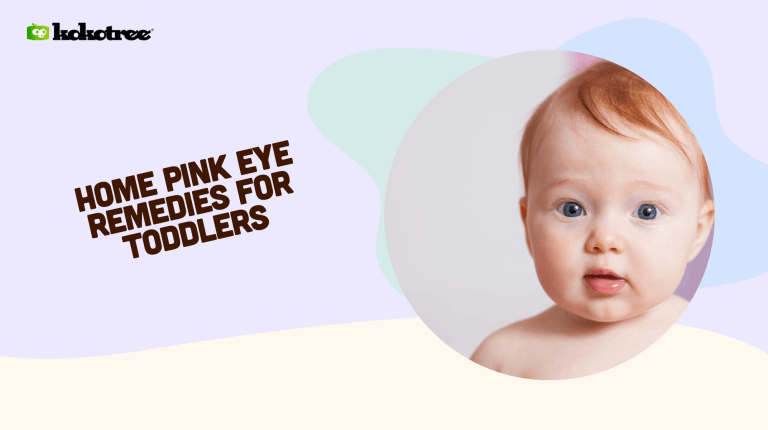

As parents, we all know that the health of our little ones is incredibly important, and dealing with illnesses can be challenging. Pink eye is a common eye infection that can affect toddlers and make them feel quite uncomfortable. The good news is that there are some safe and effective home remedies you can try to treat your child’s pink eye!
Several home remedies for pink eye in toddlers include using a warm or cool compress, saline eye drops, and maintaining proper hygiene.
When applying a warm or cool compress, use a clean cloth soaked in warm or cold water, and gently hold it over your child’s closed eye for a few minutes.
Saline eye drops can also help to wash away irritants and alleviate discomfort. Be sure to clean the eye area regularly with a damp cloth and keep your child’s hands clean.
Remember that these remedies can provide relief; however, in severe cases or if symptoms persist, consulting a pediatrician is highly recommended.
Pink eye, also known as conjunctivitis, is an inflammation or infection of the transparent membrane, called conjunctiva, that lines your toddler’s eyelid and covers the white part of the eye. When small blood vessels in the conjunctiva become inflamed, they’re more visible, causing the eye to appear pink or red. Pink eye can be caused by various factors, including viruses, bacteria, allergens, and irritants.
Before discussing home remedies, it’s crucial to recognize the symptoms of pink eye in your child. Common symptoms include redness and inflammation, watery or pus-like discharge, itchiness, sensitivity to light, and crusting on the eyelids. Being aware of these symptoms will help you better understand when to try home remedies or seek professional care for your toddler’s health.
Applying a warm or cool compress to your toddler’s affected eye can help alleviate discomfort and reduce swelling. Warm compresses are particularly useful for bacterial or viral pink eye, while cool compresses work well for allergy-related pink eye.
To prepare a compress, simply soak a clean cloth in warm or cool water, wring it out, and gently hold it over your child’s closed eye for about 5-10 minutes. Repeat this process several times a day, and always use a fresh cloth for each application to avoid spreading the infection.
Over-the-counter saline eye drops can help keep your child’s eye clean and provide relief from irritation. These drops can help wash away any allergens or irritants that could be contributing to the infection, making them a useful tool for treating pink eye at home.
When administering eye drops, ensure you follow product instructions and remember to never touch the tip of the dropper to any surface, including your toddler’s eye, to avoid contamination.
Practicing proper hygiene is essential for successful at-home treatment and preventing the spread of pink eye. Regularly clean your child’s eye area using a fresh, damp cloth, and dispose of or wash the cloth after each use.
Encourage frequent handwashing for all family members, especially the affected toddler, and avoid sharing towels, bedding, and toys during the course of the infection. By maintaining a clean environment, you’ll be able to better manage your child’s pink eye and prevent it from affecting others in your household.
A healthy diet can play a role in combating pink eye and maintaining overall eye health. Boosting your toddler’s immune system with immune-supportive foods, such as fruits, vegetables, whole grains, and lean proteins, can help their body fight off infections more effectively.
Additionally, foods rich in vitamins A, C, and E, as well as zinc and omega-3 fatty acids, promote optimal vision and eye health. Consider incorporating these nutrient-dense foods into your child’s daily meals.
While home remedies can often effectively treat pink eye, it’s crucial to monitor your child’s symptoms closely and recognize when professional care is necessary.
If symptoms worsen, do not improve within a week, or if your child complains of severe pain or vision changes, it’s essential to consult your pediatrician or an eye care professional. They can provide proper diagnosis, prescribe medication (if necessary), and guide you through appropriate treatment options.
As your child recovers from pink eye, you might be looking for fun, engaging activities to keep them entertained and support their development.
Your child’s condition provides a unique opportunity to focus on activities that emphasize fine motor skills, cognitive development, and language skills, without putting strain on their eyes.
Offer your child creative play options such as painting, sculpting with clay, or building with blocks, as these all support fine motor skills without heavily relying on vision.
Introducing your child to educational apps for toddlers can be another great way to support their learning during their recovery period.
Look for apps that focus on auditory learning, such as storytelling, rhymes, or songs. Remember to limit screen time, and adjust the brightness of the device to reduce strain on your child’s affected eye.
Combining entertaining learning experiences with restorative downtime is essential to facilitate a full recovery without sacrificing toddler development.
Treating pink eye in toddlers at home doesn’t have to be daunting. By exploring safe and effective remedies such as compresses, saline eye drops, and maintaining good hygiene, you can actively care for your child’s eye health.
Don’t forget to monitor their symptoms and seek professional help if necessary. Meanwhile, engage your child with creative activities and educational apps for toddlers to support their development during the recovery process.
Together, these efforts can help your child overcome pink eye and get back to their normal, happy self.
Besides treating pink eye, it’s essential to be proactive in supporting your toddler’s eye health in general. Encouraging healthy habits can help prevent eye infections and ensure optimal vision as they grow. Here are some useful tips for maintaining your child’s eye health and minimizing the risk of future infections:
Scheduling regular eye checkups for your child is crucial in detecting and addressing any potential vision problems before they worsen. Pediatricians often conduct simple vision screenings, but you can also visit an optometrist for a more comprehensive eye exam. Early detection and treatment of vision issues will positively impact your child’s overall health and toddler education.
Allergic triggers such as pollen, dust, and pet dander can cause allergic pink eye in some children. Identifying and minimizing exposure to these allergens will assist in preventing future episodes. Keep your home clean, use allergen-reducing products like air purifiers and hypoallergenic bedding, and avoid exposing your child to allergens whenever possible.
Outdoor play, in moderation, can benefit your child’s visual development. Sunlight exposure is essential for good health and prevents problems such as myopia, or nearsightedness. Ensure your child has a healthy balance of indoor and outdoor activities for adequate sunlight exposure, while also safeguarding their eyes from harmful UV rays with sunglasses and a wide-brimmed hat.
Excessive screen time can strain a toddler’s developing eyes and may contribute to digital eye strain, which includes symptoms like dryness, itching, and redness. Set age-appropriate limits for screen time, encourage breaks, and implement the 20-20-20 rule, where your child takes a 20-second break to look at something 20 feet away every 20 minutes.
Eye health plays an essential role in toddler education, as a child’s ability to see clearly is fundamental to their success in learning environments.
By being proactive in supporting your child’s eye health, you’ll ensure they have a strong foundation for their cognitive, social, and emotional development.
Remember to monitor your toddler’s eye health, implement preventative measures, and seek professional care whenever needed to help them achieve a lifetime of healthy vision.
If you still have questions about pink eye remedies for toddlers, fear not! We’ve compiled a list of frequently asked questions and their answers to help guide you through the process of treating your child’s pink eye and supporting their overall eye health.
Pink eye in toddlers can be caused by various factors, such as viruses, bacteria, allergies, or irritants like smoke and chemicals. It’s important to identify the cause to choose the best treatment approach.
Pink eye duration varies based on the cause. Viral pink eye typically lasts 5-7 days, while bacterial pink eye may resolve within a few days with antibiotic treatment. Allergic pink eye clears up when the allergens are avoided.
Pink eye caused by viruses or bacteria is contagious, whereas pink eye due to allergies or irritants is not. It’s essential to practice proper hygiene to minimize the spread of infection within your household.
It’s typically best to keep your child home until symptoms improve, or until they’ve had antibiotic eye drops for at least 24 hours (in the case of bacterial pink eye). Check your daycare’s policy on infectious illnesses before sending your child back.
Over-the-counter saline eye drops are generally safe for toddlers, but it’s crucial to follow the product instructions and consult with a pediatrician if you’re uncertain. Avoid using medicated eye drops without a doctor’s recommendation.
If your toddler’s eye redness is accompanied by other symptoms such as discharge, itchiness, light sensitivity, or crusting on the eyelids, it’s more likely they have pink eye.
Yes, adults can catch pink eye from a toddler if it’s caused by a virus or bacteria. Practicing good hygiene can help reduce the risk of transmission within your household.
While a healthcare professional should provide an accurate diagnosis, some common differences include: viral pink eye is often accompanied by cold-like symptoms, bacterial pink eye tends to produce pus-like discharge, and allergic pink eye may cause other allergy symptoms like sneezing.




